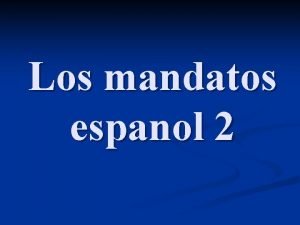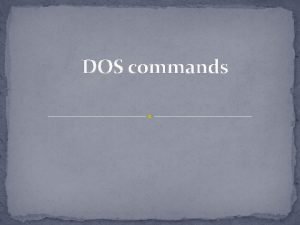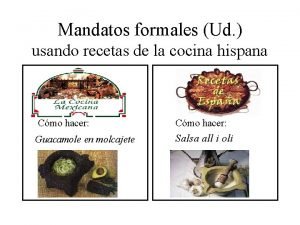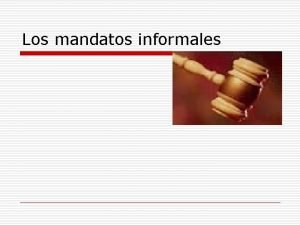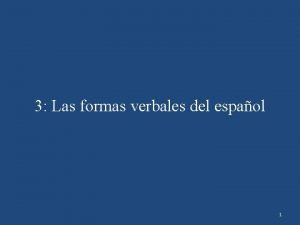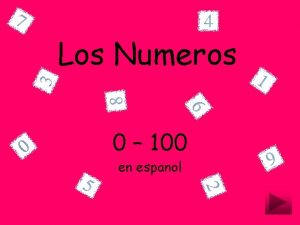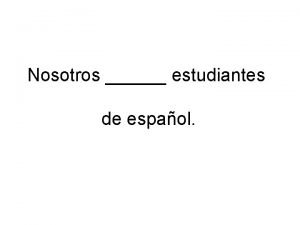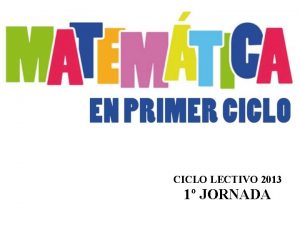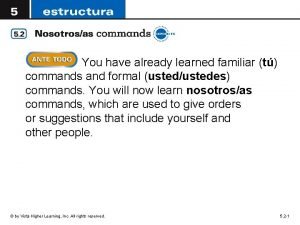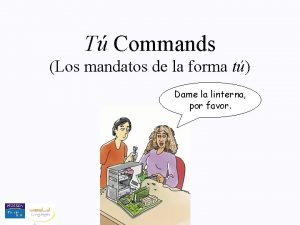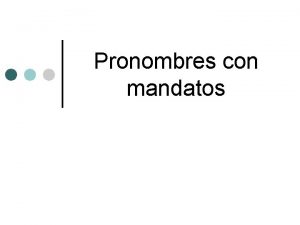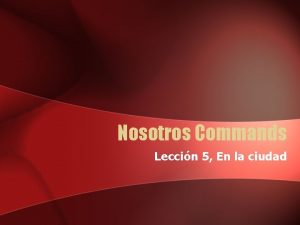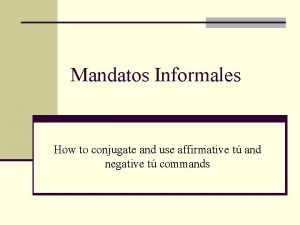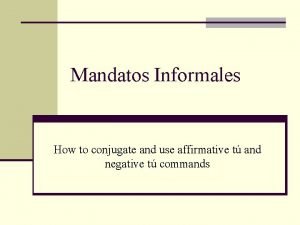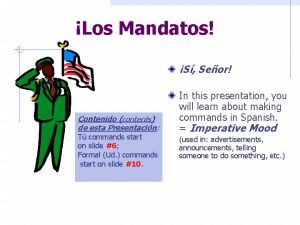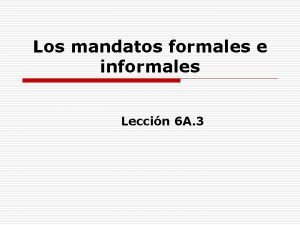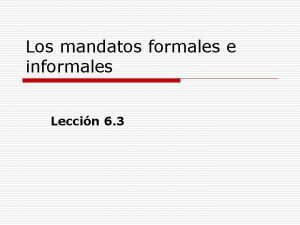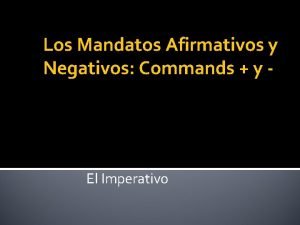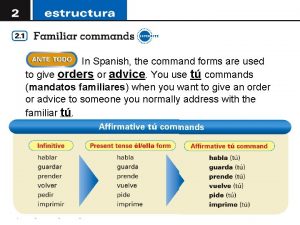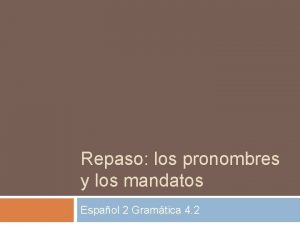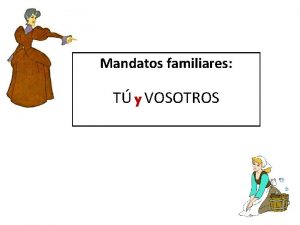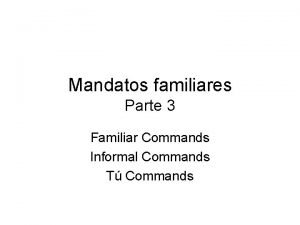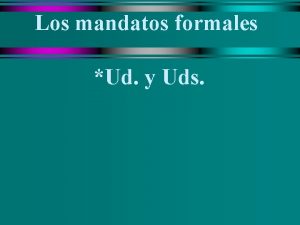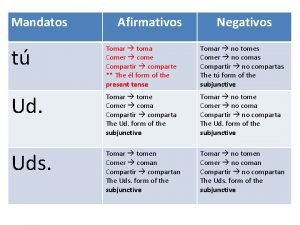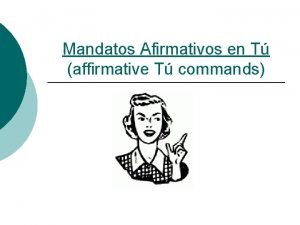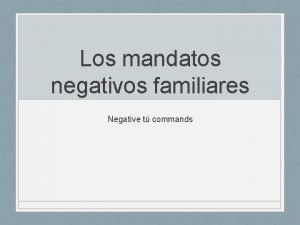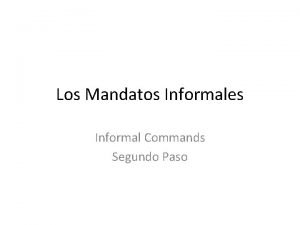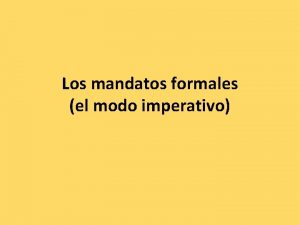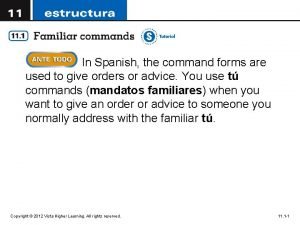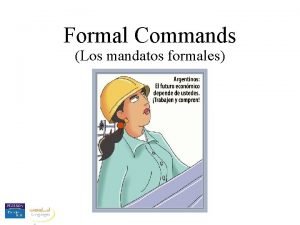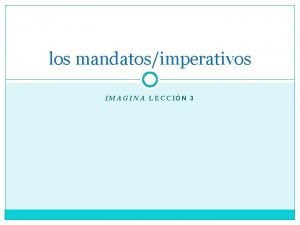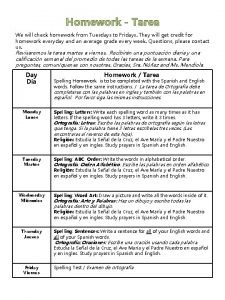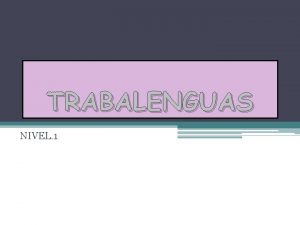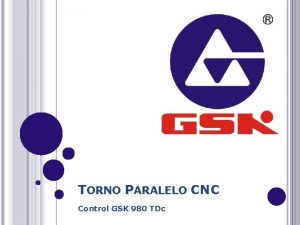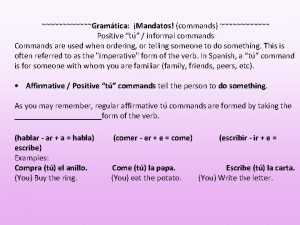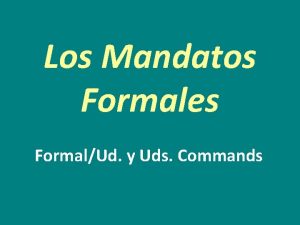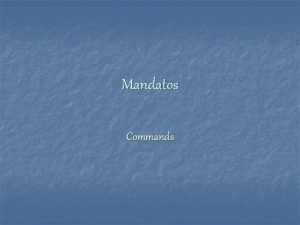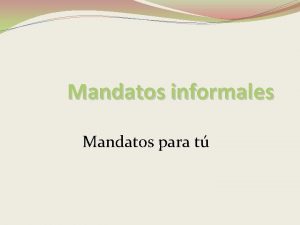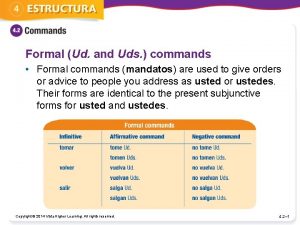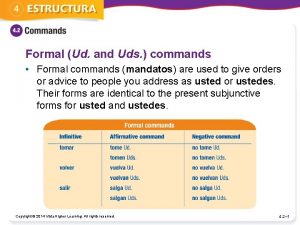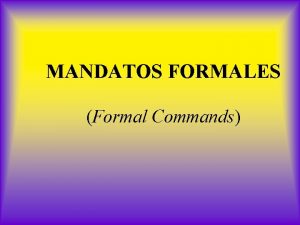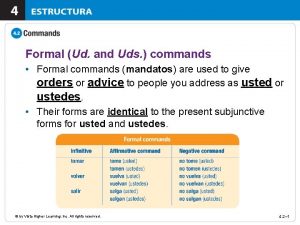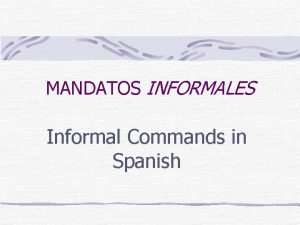Los mandatos espanol 2 Mandatos n Are commands





















































- Slides: 53

Los mandatos espanol 2

Mandatos? n Are commands: words that we use to ask favors or when we give orders or teach people of how to do something. Ex: when you order food. n When you give a recipe n When you give directions n When you explain how to do something. n

MANDATOS (INFORMAL -TÚ)

AFIRMATIVOS = positivos

Como se forma un mandato? You have to follow a very single step that I am going to explain it in three steps. Remember we have irregular verbs as well

Paso 1 n You need an infinitive=a verb n Ex: hablar

Paso #2 n Conjugate the verb to the third person singular n Third person singular: (él, ella or usted) n Ex: él habla

Paso #3 Remove “el” n Leave “habla” alone and add the word “por favor” n n Ex: habla por favor. (please talk)

Algunos voluntarios En el pizarrón. n Vamos a practicar n

Que mandatos regulares usamos todos los dias en la clase de espanol? 1. 2. 3. 4. 5. 6. 7. 8. 9. 10. n _______ (sacar) una hoja de papel _______ (guardar) silencio _______ (guardar) tu teléfono _______ (poner)* atención _______ (limpiar) tu escritorio _______ (pasar) por favor _______ (abrir) la puerta _______ (cerrar) * la puerta por favor _______ (regresar) a tu asiento _______ (apagar) la luz _______ (sentarse) por favor ****

Practica con tu companero 1. 2. 3. 4. 5. 6. 7. 8. 9. 10. Hablar Comer Jugar Correr Nadar Compra Pagar Lipiear Escribir Leer

Irregulares Decir – di Hacer – haz Poner – pon Salir – sal Ser – sé Tener – ten Ir – ve Venir - ven

Day 2 n Parte 2 de mandatos

Pronoun Placement For affirmative tú commands the direct, indirect, and reflexive pronouns are attached. AFFIRMATIVE = ATTACH The order of the pronouns is: 1. Reflexive 2. Indirect 3. Direct

Por ejemplo: Give me the homework = Dame la tarea. Or Dámela. Sit down = Siéntate. Stand up = Levántate. Do it now = Hazlo ahora.

Practicamos 1. 2. 3. 4. 5. 6. 7. 8. 9. (Hacer) ______ la tarea. (Hablar) _______ con un companero. (Cantar) _______ una cancion. (Decir) ______ la verdad. Vivir) _______ feliz con lo que tienes. Poner) _______ atencion. Venir) _______ aqui por favor. Bailar) ______ conmigo. Mantener) ____ el orden por

Practicamos 1. 2. 3. 4. 5. 6. 7. 8. 9. 10. Hacer haz Hablar habla Cantar canta di Decir vive Vivir Poner pon ven Venir baila Bailar Mantener manten limpiar limpia

NEGATIVOS

1. 2. 3. Mandatos negativos informales (Negative tú commands) Pon el verbo en la forma yo. Quita la –o. Pon las terminaciones: -ar -er / -ir -es -as

Por ejemplo dejar yo dejo No dejes creer yo creo No creas

Irregulares - Negativos - car, -gar, -zar take their –car, gar, -zar endings: sacar = No saques llegar = No llegues almorzar = No almuerces

Irregulares - Negativos DISHES Dar = no des Ir = no vayas Saber = no sepas Haber = no hayas Estar = no estés Ser = no seas

1. 2. 3. 4. 5. 6. 7. 8. No dar No cantar No hablar No vivir No olvidar No poner No salir No des No cantes No hables No vivas No olvides No pongas No salgas No vayas No seas No hagas

Pronoun Placement When the command is negative the pronoun goes BEFORE the command. Por ejemplo: No termines la tarea. = No la termines. No (levantarse) temprano. = No te levantes temprano.

MANDATOS FORMALES (UD. /UDS. COMMANDS)

Mandatos formales afirmativos(Ud. ) To address adults: 1. Conjugate the verb to the yo form present tense. 2. Drop off the –o 3. Add the formal command ending: -ar -er / -ir -e -a

Por ejemplo: cocinar 1. 2. 3. Yo cocino Yo cocin Por favor cocine

Mandatos formales afirmativos(Uds. ) Para expresar cortesía: 1. Pon el verbo el la forma yo 2. Quita la –o 3. Pon las terminaciones: -ar -er / -ir -en -an

Por ejemplo: sentar yo sienten Comer Yo coman

Irregulares DISHES dar ir saber ser dé vaya sepa sea den vayan-car, sepan -gar, sean haber hayan -zar -car -que, quen -gar -gue, - estar estén

Pronoun Placement AFFIRMATIVE = ATTACH NEGATIVE = BEFORE THE VERB

Por ejemplo: Afirmativo - Attach: Por favor, escríbanos su nombre. Negativo – Before the verb. No, no nos escriba su nombre.

NOSOTROS COMMANDS

Nosotros commands translate to “let’s” do something. Another way to express this is: ir a + infinitive. Ej. Vamos a comer en este restaurante. (Let’s eat in this restaurante. )

Nosotros Commands 1. 2. 3. Pon el verbo en la forma yo. Quita la –o. Pon las terminaciones: -ar -er / -ir -emos -amos (Es la forma de nosotros del subjuntivo)

Por ejemplo Comer Yo como Comamos, No comamos Hablar yo hablo Hablemos, no hablemos

Irregulares – D I S H E S Dar = demos, no demos Ir = vamos, no vayamos Saber = sepamos, no sepamos Haber = hayamos, no hayamos Estar = estemos, no estemos Ser = seamos, no seamos

Stem-Changing Verbs n Stem-changing –ar/-er DO NOT change. Por ejemplo: Cerremos la puerta. n Stem-changing –ir verbs change e-i or o-u. Por ejemplo: No durmamos. Pidamos la cuenta.

Stem-changing -ir verbs n Dormir n Pedir n Repetir n Sentirse n Competir n Medir n Servir n teñir n Vestir n conseguir

-car, -gar, -zar -car -quemos Saquemos, no saquemos n -gar, -guemos Lleguemos, no lleguemos n -zar - cemos almorcemos, no almorcemos n

n Indirect Pronoun Placement (IOP/DOP) and direct object pronouns are attached to the end of affirmative commands. Ej: Comprémoslos – Let’s buy them. n Indirect and direct object pronouns are placed before negative commands. Ej: No los compremos. - Let’s not buy them.

n Pronoun Placement (Reflexives) To add a reflexive verb to an affirmative command the “s” must be dropped before “nos” is added. Ej. Let’s sit. = Sentémonos. n The reflexive pronoun goes before the verb in a negative command. Ej. Let’s not sit. = No nos sentemos.

Accents are placed on the “e” of –emo(s) and the “a” of amo(s) in an affirmative command when one or two pronouns are attached. Ej. Let’s sell it to her. = Vendámoselo. Let’s put them on. = Pongámonoslos.

VOSOTROS COMMANDS

Vosotros Commands Affirmative n Replace the final “r” of the infinitive with a “d”. Ej. Hablar = hablad Volver = volved ir = id comer = comed

Negative Vosotros Commands el verbo en la forma yo. n Quita la –o EL n Pon las terminaciones: SUBJUNTIVO -ar -er/-ir -éis -áis Ej. No habléis No volváis No vengáis n Pon

Irregulares – D I S H E S Dar = no deis Ir = no vayáis Saber = no sepáis Haber = no hayáis Estar = no estéis Ser = no seáis

Stem-changing verbs n -ar / -er verbs DO NOT change. Ej. Don’t close the door! = No cerréis la puerta! n -ir verbs CHANGE e-i or o-u. Ej. Don’t sleep! = No durmáis.

-car, -gar, -zar -car: -quéis -gar: -guéis -zar: -céis Ej. No toquéis Ej. No lleguéis Ej. No almorcéis

n Indirect Pronoun Placement and direct object pronouns are attached to the end of an affirmative command. Ej. Wash it! = Lavadlo n Accents are placed on –a(d), -e(d), or –i(d) of an affirmative command when there are 2 pronouns. Ej. Put them on! = Ponéoslos. Dádmelo n Indirect and direct object pronouns go

Pronoun Placement Reflexives n To add a reflexive pronoun to an affirmative command the “d” must be dropped before “os” is added. For –ir verbs, this also requires an accent mark over the “i”. Ej. Lie down! = Acostaos Don’t lie down. = No os acostéis Get dressed = Vestíos Don’t get dressed = No os vistáis

Exception… One exception is irse. For irse ‘d’ is NOT dropped. irse = Idos

EL FIN
 Antigentest åre
Antigentest åre Mandatos en espanol
Mandatos en espanol What is internal commands
What is internal commands Mandatos spanish
Mandatos spanish Mandatos en espanol
Mandatos en espanol Recetas en inglés paso a paso
Recetas en inglés paso a paso Los mandatos informales
Los mandatos informales Letra que canten los niños jose luis perales
Letra que canten los niños jose luis perales Los tiempos verbales en español
Los tiempos verbales en español Los numeros 0-100
Los numeros 0-100 Nosotros estudiantes de español
Nosotros estudiantes de español Partes mano
Partes mano Como trabajar los unos los dieces y los cienes
Como trabajar los unos los dieces y los cienes Indica los mandatos afirmativos y negativos
Indica los mandatos afirmativos y negativos Los mandatos informales
Los mandatos informales Capitulo 3b irregular affirmative tu commands
Capitulo 3b irregular affirmative tu commands Mandatos con nosotros
Mandatos con nosotros Intentalo indica los mandatos
Intentalo indica los mandatos Mandatos informales irregulares
Mandatos informales irregulares Mandatos informales examples
Mandatos informales examples Ser mandatos informales
Ser mandatos informales Mandatos informales conjugation
Mandatos informales conjugation Los mandatos familiares afirmativos y negativos
Los mandatos familiares afirmativos y negativos Los mandatos informales
Los mandatos informales Mandatos formales reflexivos
Mandatos formales reflexivos Mandatos informales y formales
Mandatos informales y formales Mandatos afirmativos y negativos
Mandatos afirmativos y negativos Intentalo indica los mandatos afirmativos y negativos
Intentalo indica los mandatos afirmativos y negativos Affirmative formal command
Affirmative formal command Pronombres con mandatos
Pronombres con mandatos Vosotros mandatos
Vosotros mandatos Los mandatos de nosotros
Los mandatos de nosotros Practicar tu command
Practicar tu command Mandatos afirmativos y negativos con ud. y uds.
Mandatos afirmativos y negativos con ud. y uds. Dar mandato afirmativo
Dar mandato afirmativo Los mandatos del señor son rectos y alegran el corazon
Los mandatos del señor son rectos y alegran el corazon Mandato afirmativo y negativo
Mandato afirmativo y negativo Practicar formal command
Practicar formal command Mandatos familiares negativos
Mandatos familiares negativos Los mandatos familiares afirmativos y negativos
Los mandatos familiares afirmativos y negativos Los mandatos informales
Los mandatos informales Dar mandatos formales
Dar mandatos formales Mandatos plurales
Mandatos plurales Indica los mandatos afirmativos y negativos de estos verbos
Indica los mandatos afirmativos y negativos de estos verbos Mandatos formales vs informales
Mandatos formales vs informales Mandatos formales irregulares
Mandatos formales irregulares Mar territorial español
Mar territorial español Padre nuestro en inglés y español
Padre nuestro en inglés y español Verbos tobe en ingles y español
Verbos tobe en ingles y español Vamos a aprender español
Vamos a aprender español Utz ipetik en español
Utz ipetik en español Trabalenguas en mam y español
Trabalenguas en mam y español Codigos miscelaneos cnc
Codigos miscelaneos cnc Autor de sublime gracia
Autor de sublime gracia

